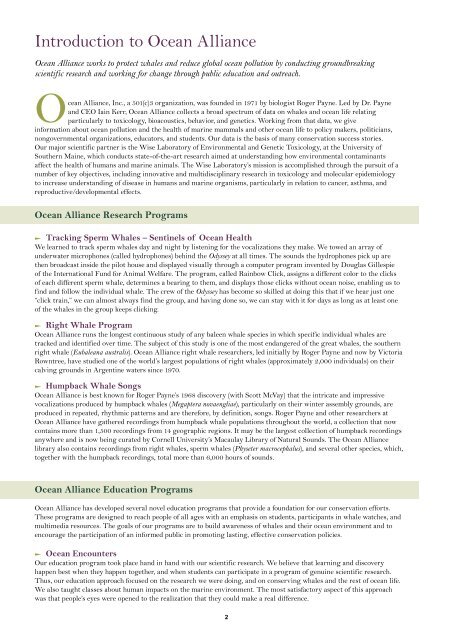Voyage of the Odyssey executive summary - Ocean Alliance
Voyage of the Odyssey executive summary - Ocean Alliance
Voyage of the Odyssey executive summary - Ocean Alliance
You also want an ePaper? Increase the reach of your titles
YUMPU automatically turns print PDFs into web optimized ePapers that Google loves.
Introduction to <strong>Ocean</strong> <strong>Alliance</strong><br />
<strong>Ocean</strong> <strong>Alliance</strong> works to protect whales and reduce global ocean pollution by conducting groundbreaking<br />
scientific research and working for change through public education and outreach.<br />
O cean <strong>Alliance</strong>, Inc., a 501(c)3 organization, was founded in 1971 by biologist Roger Payne. Led by Dr. Payne<br />
and CEO Iain Kerr, <strong>Ocean</strong> <strong>Alliance</strong> collects a broad spectrum <strong>of</strong> data on whales and ocean life relating<br />
particularly to toxicology, bioacoustics, behavior, and genetics. Working from that data, we give<br />
information about ocean pollution and <strong>the</strong> health <strong>of</strong> marine mammals and o<strong>the</strong>r ocean life to policy makers, politicians,<br />
nongovernmental organizations, educators, and students. Our data is <strong>the</strong> basis <strong>of</strong> many conservation success stories.<br />
Our major scientific partner is <strong>the</strong> Wise Laboratory <strong>of</strong> Environmental and Genetic Toxicology, at <strong>the</strong> University <strong>of</strong><br />
Sou<strong>the</strong>rn Maine, which conducts state-<strong>of</strong>-<strong>the</strong>-art research aimed at understanding how environmental contaminants<br />
affect <strong>the</strong> health <strong>of</strong> humans and marine animals. The Wise Laboratory’s mission is accomplished through <strong>the</strong> pursuit <strong>of</strong> a<br />
number <strong>of</strong> key objectives, including innovative and multidisciplinary research in toxicology and molecular epidemiology<br />
to increase understanding <strong>of</strong> disease in humans and marine organisms, particularly in relation to cancer, asthma, and<br />
reproductive/developmental effects.<br />
<strong>Ocean</strong> <strong>Alliance</strong> Research Programs<br />
l Tracking Sperm Whales – Sentinels <strong>of</strong> <strong>Ocean</strong> Health<br />
We learned to track sperm whales day and night by listening for <strong>the</strong> vocalizations <strong>the</strong>y make. We towed an array <strong>of</strong><br />
underwater microphones (called hydrophones) behind <strong>the</strong> <strong>Odyssey</strong> at all times. The sounds <strong>the</strong> hydrophones pick up are<br />
<strong>the</strong>n broadcast inside <strong>the</strong> pilot house and displayed visually through a computer program invented by Douglas Gillespie<br />
<strong>of</strong> <strong>the</strong> International Fund for Animal Welfare. The program, called Rainbow Click, assigns a different color to <strong>the</strong> clicks<br />
<strong>of</strong> each different sperm whale, determines a bearing to <strong>the</strong>m, and displays those clicks without ocean noise, enabling us to<br />
find and follow <strong>the</strong> individual whale. The crew <strong>of</strong> <strong>the</strong> <strong>Odyssey</strong> has become so skilled at doing this that if we hear just one<br />
“click train,” we can almost always find <strong>the</strong> group, and having done so, we can stay with it for days as long as at least one<br />
<strong>of</strong> <strong>the</strong> whales in <strong>the</strong> group keeps clicking.<br />
l Right Whale Program<br />
<strong>Ocean</strong> <strong>Alliance</strong> runs <strong>the</strong> longest continuous study <strong>of</strong> any baleen whale species in which specific individual whales are<br />
tracked and identified over time. The subject <strong>of</strong> this study is one <strong>of</strong> <strong>the</strong> most endangered <strong>of</strong> <strong>the</strong> great whales, <strong>the</strong> sou<strong>the</strong>rn<br />
right whale (Eubaleana australis). <strong>Ocean</strong> <strong>Alliance</strong> right whale researchers, led initially by Roger Payne and now by Victoria<br />
Rowntree, have studied one <strong>of</strong> <strong>the</strong> world’s largest populations <strong>of</strong> right whales (approximately 2,000 individuals) on <strong>the</strong>ir<br />
calving grounds in Argentine waters since 1970.<br />
l Humpback Whale Songs<br />
<strong>Ocean</strong> <strong>Alliance</strong> is best known for Roger Payne’s 1968 discovery (with Scott McVay) that <strong>the</strong> intricate and impressive<br />
vocalizations produced by humpback whales (Megaptera novaengliae), particularly on <strong>the</strong>ir winter assembly grounds, are<br />
produced in repeated, rhythmic patterns and are <strong>the</strong>refore, by definition, songs. Roger Payne and o<strong>the</strong>r researchers at<br />
<strong>Ocean</strong> <strong>Alliance</strong> have ga<strong>the</strong>red recordings from humpback whale populations throughout <strong>the</strong> world, a collection that now<br />
contains more than 1,500 recordings from 14 geographic regions. It may be <strong>the</strong> largest collection <strong>of</strong> humpback recordings<br />
anywhere and is now being curated by Cornell University’s Macaulay Library <strong>of</strong> Natural Sounds. The <strong>Ocean</strong> <strong>Alliance</strong><br />
library also contains recordings from right whales, sperm whales (Physeter macrocephalus), and several o<strong>the</strong>r species, which,<br />
toge<strong>the</strong>r with <strong>the</strong> humpback recordings, total more than 6,000 hours <strong>of</strong> sounds.<br />
<strong>Ocean</strong> <strong>Alliance</strong> Education Programs<br />
<strong>Ocean</strong> <strong>Alliance</strong> has developed several novel education programs that provide a foundation for our conservation efforts.<br />
These programs are designed to reach people <strong>of</strong> all ages with an emphasis on students, participants in whale watches, and<br />
multimedia resources. The goals <strong>of</strong> our programs are to build awareness <strong>of</strong> whales and <strong>the</strong>ir ocean environment and to<br />
encourage <strong>the</strong> participation <strong>of</strong> an informed public in promoting lasting, effective conservation policies.<br />
l <strong>Ocean</strong> Encounters<br />
Our education program took place hand in hand with our scientific research. We believe that learning and discovery<br />
happen best when <strong>the</strong>y happen toge<strong>the</strong>r, and when students can participate in a program <strong>of</strong> genuine scientific research.<br />
Thus, our education approach focused on <strong>the</strong> research we were doing, and on conserving whales and <strong>the</strong> rest <strong>of</strong> ocean life.<br />
We also taught classes about human impacts on <strong>the</strong> marine environment. The most satisfactory aspect <strong>of</strong> this approach<br />
was that people’s eyes were opened to <strong>the</strong> realization that <strong>the</strong>y could make a real difference.<br />
2


